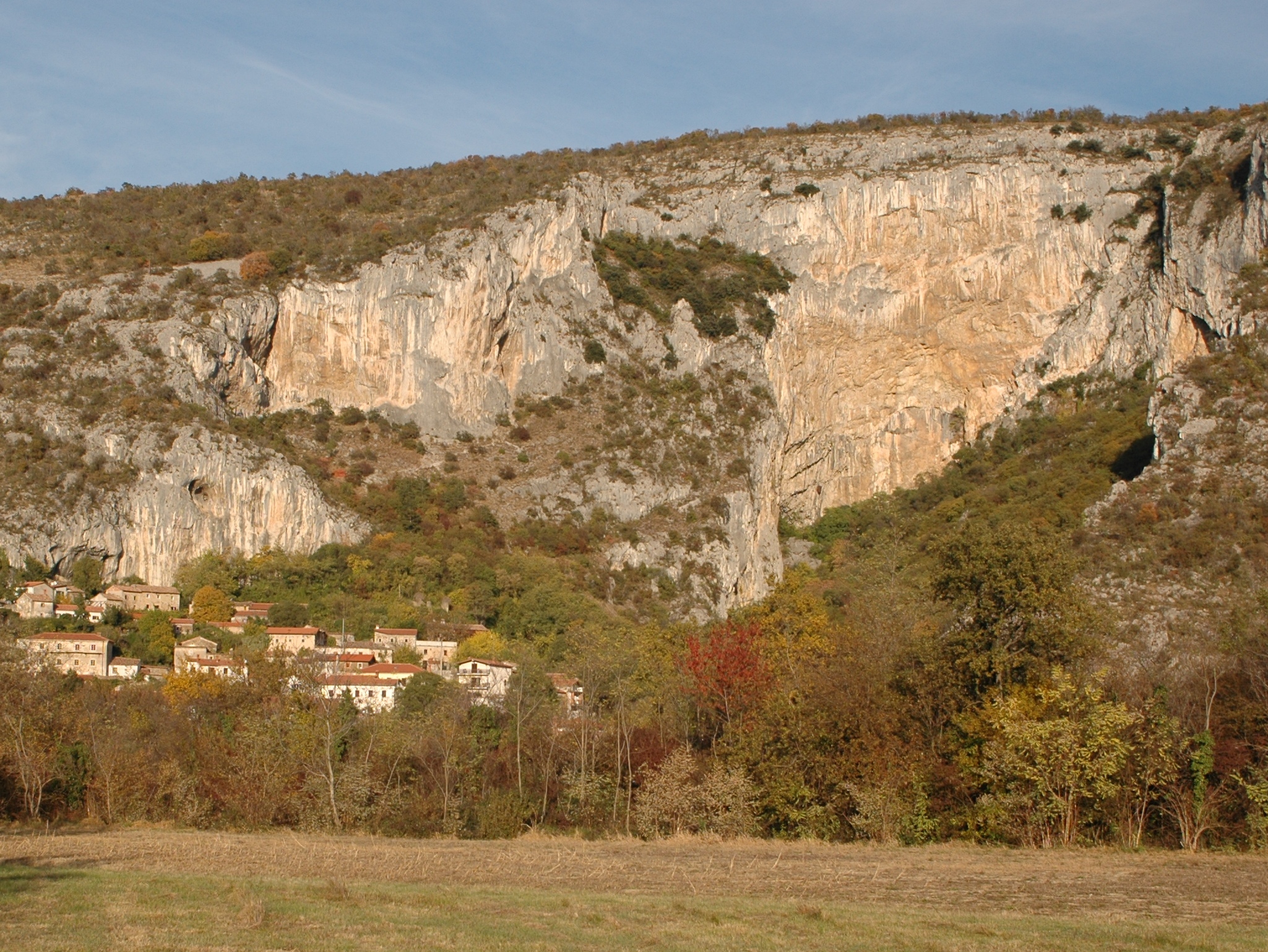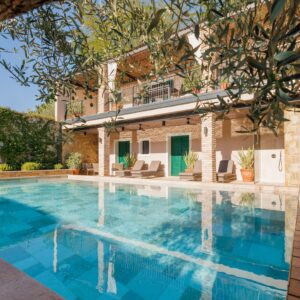Millions of years ago, when dinosaurs roamed around Kozina, two underground caves were formed under the Karst edge (*prehistoric details are purely the author’s speculation). The crash of the deadly meteorite, that rearranged the cards of living species, also caused the roofs of these caves to collapse, which many years later led to ideal conditions for one of the best climbing centers in the whole world, which even today, after several decades of conquer hasn’t lost its momentum. Apart from hundreds of routes covering the whole spectrum of difficulty, the crags are situated in a picturesque rural setting in the corner of Slovenia blessed with a mild climate. Maybe some routes are polished and maybe the crowds in peak season are not your thing, and despite the fact that climbers aren’t the most welcome visitors here, the Osp area can without shadow of doubt be mentioned in the same breath as any other climbing Mecca.
Banje (also called Behind the village) is a playground for technical climbers with vertical routes, which are surrounded on both sides by overhangs. Babna (also called The Balcony) is considered the most popular crag in the area, being just a bit harder than Črni Kal and easier than Mišja peč, with long routes on vertical and slightly overhanging walls.
But there are actually three more different crags. Srnjak is a nice sector, but in the shade of other areas, the climbing in the Big Wall is slowing down for a while, but your true attention should be directed at the magnificent The big cave of Osp with epic routes in a sea of tufa.
ACCESS
Driving from Črni kal down the valley of Osp, after the sign for the village of Osp by the first house on the left, turn right on a dirt road and after 50 meters you will find the parking. There is a sign that you have to pay the parking 5€/day, but nobody is checking that anymore, so no need to do it. First walk back to the main road towards the village.
For sectors Babna and Banje pass the bridge, then use one of the two paths uphill through the village and you will soon reach the first crag (turn right and up upon reaching the church). For Babna the path extends onwards and uphill. Use only clear, official paths.
For sectors Srnjak, The big cave of Osp and The big wall just before the bridge turn right until you reach an old playground, from where you follow the path up towards the wall, over three bridges and some slopes. For Srnjak go left before the steep slope and cross the dry riverbed, which can also lead you to The big cave of Osp with some more walking.
WEATHER
The ideal periods for climbing are from autumn until spring, when you can hardly miss a good day – you can climb even in the rain (especially Mišja peč or the big cave of Osp). Most of the winter has excellent conditions, unless you get one of the cold, windy, rainy days. When it gets dangerously hot in the summer, you can start looking for shade: it can be found in Banje, on the sides of Mišja peč and in Črni Kal. The big cave is a different story: it depends on the lake that appears out of nowhere – unless you have a kayak with you. After long periods of rain the tufas can get quite wet.
ROCK QUALITY
Osp is very well maintained. The bolts are new and bolted in a friendly fashion. There are anchors with carabiners almost everywhere. The quality of the rock is also great – but be careful while climbing longer routes on the right side of Babna, where an occasional hold may break off. Sometimes a loose rock may be launched on the climbers by naughty animals above the wall. The comfort under the wall is generally excellent, even for children – if they manage to walk all the way up.
In Luknja the rock is excellent – but a tufa or two may break off (so belayers watch out!). On the edges the rock is sometimes quite rotten. Big Wall deteriorates more on the upper part, where you also need some courage and experience with climbing multi pitches. Routes are bolted nicely, but do mind the worn out quickdraws. There is room for the entire village under the wall.
ENVIROMENTAL NOTES
The Karst edge is situated in an exceptional natural environment with a biological explosion of species, out of which 277 are endangered and 28 endemic. Apart from that, this area supports a mainly rurally oriented population, that cherishes peace and a respectful attitude. Even though spheres of interest of many groups meet in the area, the climbers should be the least problematic, which many times isn‘t the case. If you personally don‘t care about preserving a good relationship with locals, the unspoilt Karst heritage and Mediterranean nature, at least try to behave for the sake of the climbing community, that often carries the consequences of outbursts of individuals. The basic guidelines are contained in the climber‘s code in this topo, along with your common sense – act at least in the way you would want others to act on your backyard. The future may hold one more or one less nice climbing area.
RECOMMENDED ACCOMMODATIONS
ROUTES (from left to right)
Banje is characterized by vertical routes of middle grades and a bit harder routes over the bulges with explicit cruxes. Babna is more diverse and offers a lot of joy for complete beginners in vertical routes on sharp holds, requiring good footwork. Harder routes in 7s become slightly overhanging, long, technical endurance pieces, and later also the power comes into play. Around 8s the routes start to dwindle. There are also some multipitches. Old routes can be very polished and many are full of artificially chipped holds.
The standard gear is adequate. Still, be aware of the route lengths – sometimes even an 80 m rope is a bit short. You need almost 20 QDs for longer routes.
Srnjak offers easier vertical routes with sharp holds and small footholds. There are some nice multipitches in the Big Wall, but take your time with those. The big cave of Osp has classic endurance pieces, the best from 7a and more. The holds are good, with many tufas and mushrooms. You will get a a lot of pumping until you get cramps, true 3D climbing and many interesting cruxes. Of course you need to adapt to this style a little, but once you get going, it‘s the best.
Routes are looong, even over 50 meters, but due to the overhang you can use 80 meter rope. You will also need a lot of quickdraws, at least 16. For the Big wall you usually don‘t need extra gear (nuts, friends,…), but they can come in handy. Watch out, as the sand deteriorates you gear. In Srnjak and Big Wall it is advised to wear a helmet.
A – Sector Behind the village AKA Banje
| Osapski pajek | 8b+ | 18m |
| Matičkov svet | 8b | 18m |
| Osapska mumija | 8b | 18m |
| Karies | 8a+ | 18m |
| Vinko Coce | 8b | 18m |
| Gronolom | 8a | 19m |
| Šamanski prehod | 7c | 21m |
| Amazonka | 6b | 21m |
| Ženska finalna 88 | 6b | 18m |
| Indijanka | 6a+ | 18m |
| The Long Run | 7a | 20m |
| Triceratops | 7c | 20m |
| Paris – Dakar | 7c | 20m |
| Pariški vrt | 7b | 20m |
| The Garden | 7c+ | 20m |
| Mlado vino | 7b | 20m |
| Supersok | 7c | 23m |
| Superhik | 6c+ | 35m |
| Varianta Superhik | 6c+ | 32m |
| Varianta Poljanski biser | 6c+ | 32m |
| Poljanski biser | 7a+ | 32m |
| Uparjalnik | 7c | 32m |
| Super Elio | 7a+ | 27m |
| Super Emil | 6c | 27m |
| Super luknja | 6a | 25m |
| Super Elica | 6a+ | 25m |
| Tačko | 6c | 25m |
| Le mavrica | 7b | 26m |
| Domana | 7c+ | 15m |
| Virus | 7c | 15m |
| Jebiga | 6b+ | 25m |
| Skriti zaklad (1.part) | 7b+ | 25m |
| Skriti zaklad (to the top) | 7b+ | 37m |
| Super beta | 7a | 26m |
| Banje (1st part) | 7b | 19m |
| Banje (to the top) | 7b+ | 33m |
| P | ? | 19m |
| Gad | 8a | 19m |
| Osapska | 7c | 35m |
| Kalifornija | 7c | 22m |
| Kranjski Janez | 7c | 35m |
| Polnočni kavboj | 7c | 20m |
| Galeb | 7b | 30m |
| Jonathan Livingstone | 7a | 33m |
| Jonagold | 7c | 23m |
| Poročna noč | 7c | 23m |
| Zakonska kriza | 7c | 23m |
| Festivalska | 7c | 20m |
| Branko | 7b+ | 20m |
| Brankova kriza | 7b+ | 20m |
| Mibranko | 6c+ | 20m |
| Miklavž | 7b | 18m |
| Božiček | 6c+ | 18m |
| Alenka L.T. | 6b+ | 14m |
| Dedek Mraz | 6c | 18m |
B – Sector The Balcony AKA Babna
| Pišta, Feri, Lajči | 3 | 16m |
| Ledika | 4a | 16m |
| Mufta | 4b | 15m |
| Bograč | 5a | 18m |
| Gibanica | 4c | 18m |
| Taca muca | 6b+ | 20m |
| Caprice | 7a+ | 23m |
| Sapramiška | 7b | 21m |
| Pablo pes | 7c | 21m |
| Puzza di Cipolla | 7b | 21m |
| Mai una gioia | 7b+ | 25m |
| Fantastic Voyage | 8a+ | 25m |
| Mosquitos wall | 7b+ | 19m |
| Črna gradnja | 8a | 23m |
| Buena suerte | 7b+ | 19m |
| Idealist | 7a+ | 19m |
| Jebena zima | 7b | 35m |
| Trio Fantasticus 1.part | 6c+ | 20m |
| Trio Fantasticus | 7a | 34m |
| Leva bunkica | 6c | 16m |
| Desna bunkica | 6b+ | 16m |
| Senza corrente | 7c+ | 15m |
| Hrenovnjača | 6b+ | 12m |
| Bohomurček | 6b | 12m |
| Ospomaniak 1.part | 6c+ | 16m |
| Ospomaniak (to the top) | 7a | 37m |
| El Garbo | 7a+ | 16m |
| Vstopite in se veselite | 6b | 10m |
| Grofice | 6b+ | 10m |
| Tantalove muke | 7a | 35m |
| Rutka | 4b | 30m |
| Kameleon | 6c+ | 35m |
| Daleč stran je sodni dan | 7b | 34m |
| Si puo fare | 7b+ | 35m |
| Eolo | 7c | 30m |
| Eolo (to the top) | 7c+ | 35m |
| Fragile 1.part | 7b+ | 25m |
| Fragile (to the top) | 7c | 35m |
| Sončni dnevi | 7b | 21m |
| Rainy days | 7b | 21m |
| Ko bo padal dež | 7c+ | 35m |
| Frenki boy | 7c+ | 35m |
| Šok terapija | 7b | 16m |
| Joint | 7b | 35m |
| Demolition party | 7a+ (6c, 7a) | 35m |
| Češpljevi cmoki | 6c+ | 19m |
| RKC | 8a | 23m |
| Veper lady | 8b | 25m |
| Martinova gos | 8a+ | 25m |
| Zadnja skušnjava | 8a | 23m |
| Vegas 7 | 8a+ | 23m |
| Brancin | 8a+ | 23m |
| Delirium tremens | 7b | 30m |
| Maudit | 7a+ (7a, 7a+) | 43m |
| Zmedeni in zadeti | 6b+ | 15m |
| Pretty lady | 6c+ | 19m |
| Proletarska | 7b | 38m |
| Pretty baby | 6b+ (6a+, 6b+, 6a) | 50m |
| El diablo | 7a | 20m |
| Črna ovca | 6c | 13m |
| Don Nino | 6b+ | 35m |
| Dolgotacko | 6c | 27m |
| Jaslice | 6c+ | 38m |
| Olympic | 7a | 28m |
| Derniere surprise | 6c (6b+, 6c) | 42m |
| Le tapis volant | 6b+ (6b+, 6a) | 42m |
| Belle epoque | 6a+ | 20m |
| Ženski četrtfinale 88 | 6a | 21m |
| Murphyjev zakon | 6c+ | 16m |
| Mirage | 6c (6a, 6c) | 42m |
| Sobotna priloga | 6b+ (6a+, 6b+) | 42m |
| Chat noire | 6b | 24m |
| Hard rain | 6b+ (6b+, 6b+) | 45m |
| Prišlek | 6b+ | 45m |
| Tormiento | 6c | 22m |
| Tarantela | 6c+ (6b+, 6c+) | 40m |
| Minister za zmedo | 6b+ | 37m |
| Navihanke | 6c | 15m |
| Mr.Hilti | 6b+ | 20m |
| New look | 6b | 20m |
| Potion magique | 6b | 19m |
| Tora bora | 6c+ | 16m |
| Just married | 6b+ | 20m |
| No siesta | 6b | 20m |
| Le plasir de la soir | 6a+ | 23m |
| Take it easy | 6c | 33m |
| Steber jutranje zvezde | 6c+ (6b+, 6c+, 6c) | 65m |
| Killing me softly 1. part | 6a+ | 25m |
| Killing me softly | 7a+ | 37m |
| Killing me hardly | 7a+ | 37m |
| Špehova | 6a | 24m |
| Sea snake | 7a+ | 37m |
| Moon safari | 7b | 37m |
| Solitudine | 6b+ (5c, 6b+) | 40m |
| Love story | 5c | 24m |
| Ledeno vino | 6a | 25m |
| Vik in krik | 6a+ | 23m |
| Piccola peste | 6b (6a, 5c, 4b, 6b, 6a+) | 85m |
| Ledena sveča | 6a+ | 25m |
| Tiare Tipanie | 5a | 20m |
| Maeva | 4b | 20m |
| Čebelica Maja | 3 | 15m |
| Fetia ura | 7c+ | 30m |
| Črni biser | 7c | 30m |
| Sužnji vertikale | 7a+ | 30m |
| Za oslovo senco | 7a+ | 26m |
| Il castigo | 6b+ | 25m |
| Epena | 7a+ | 26m |
| A tout coeur | 7a (6b, 6a, 7a) | 65m |
| Toute de force | 7a | 19m |
| Severi ma giusti | 6c | 23m |
| Dolores | 6a+ | 20m |
| Čauko | 6a | 23m |
| Il giardino dell aephiornis | 6b (6a, 5b, 5b, 6b) | 75m |
| Rawhide | 6b (6a+, 6b) | 40m |
C – Sector Srnjak
| Lijin vrt | 6b+ | 30m |
| T.O. Zelena dolina | 7a+ | 30m |
| Raz | 7a+ | 30m |
| Hopla konopla | 7c | 30m |
| 4800s | 7a+ | 32m |
| Govorna driska | 7a | 32m |
| Me cago en el amor | 6c+ | 35m |
| Ringlšpil | 6b | 38m |
| Judežev poljub | 7a+ | 32m |
| Poletna noč | 6c | 30m |
| Bolj star, bolj nor | 6a+ | 36m |
| B.F. – posestnik iz Ospa | 6b | 36m |
| Sveta preproščina | 6c+ | 37m |
| Urad za nepremičnine | 7a+ | 37m |
| Silvo Faruški | 6c+ | 45m |
| Noč čarovnic | 6a | 25m |
| Ptičja gripa | 5b | 25m |
| Angel Gabriel | 6a | 22m |
| Javornik | 6c (6c, 6b+, 6b) | 50m |
| Čudna so pota ljubezni | 6a+ | 20m |
D – Sector The Big Cave of Osp
| Pila | 6b+ | 30m |
| Žagca | 6c+ | 30m |
| Žaga | 6a+ | 35m |
| Sekolar | 6b | 35m |
| Steber spominov | 7a+ (6a, 7a+, 6c+, 6b, 6a) | 85m |
| Vitez iz Poljan | 7a | 30m |
| Z balonom do sreče | 7a | 30m |
| Pikapoka | 7b | 30m |
| Pooping without peeing | 7b+ | 30m |
| Dance without sleeping | 7b | 30m |
| Poskus ni ples | 7b+ | 30m |
| Try (just a little bit harder) | 7b | 30m |
| Try (just a little bit harder) | 7b+ (7b, 6c+, 7b+, 7b, 6c, 7a) | 140m |
| 4 bis (same start as Tržaška, then left) | 7b+ | 30m |
| Bazoviška (same start as Tržaška, then straight) | 7a+ | 20m |
| Tržaška smer L1 | 7b | 25m |
| Tržaška smer (L1 + L2) | 7b+ | 35m |
| Tržaška smer | 7b+ (7b+, 7b+, 7a, 6b+, 6a) | 95m |
| Varianta Tržaške – Supernova | 7a+ (7b, 6b, 6a) | 80m |
| Leon | 8b | 35m |
| Mamka Bršljanka | 6c | 20m |
| Working Leon | 8c | 35m |
| Working class hero | 8b | 35m |
| Water world | 9a | 55m |
| Poletna poč | 6c+ | 12m |
| Osapska pošast L1 | 7c+ | 25m |
| Bala Bala | 8b (8b, 7c, 6c,7c,7a+) | 140m |
| Osapska pošast | 8c | 55m |
| Helikopter v pošasti | 8c | 55m |
| Helikopter v omaki | 8b | 26m |
| Bitka s stalaktiti | 8b | 55m |
| Baram Baram | 8a | 20m |
| Revolucija | 8c+ | 30m |
| Halupca 1979 | 9a | 27m |
| Troja | 8a+ | 25m |
| Troja extension | 8c | 40m |
| Couch surfing (2nd extension of Troja) | 8c+ | 55m |
| Trojanski konj | 7c+ | 18m |
| Laokoon (extension of Trojanski konj) | 8a | 25m |
| Zimovc | 6b | 8m |
| Sedmica | 6c | 8m |
| Active discharge L1 | 8a | 25m |
| Active discharge (to the top) | 8b+ | 55m |
| Jerca Žverca | 7b | 15m |
| Šatida Bagaba | 6a+ | 15m |
| Rudolfo | 5c | 15m |
| The secret project (extension of Rudolfo) | 8c+ | 55m |
| Aktivna burja | 7b+ | 35m |
| Leva burja | 7b+ | 30m |
| Črna burja – Bora scura (L1) | 7b | 30m |
| Črna burja – Bora scura (to the top) | 7c (7b, 7c, 7b, 7c, 7a+, 6c) | 140m |
| Magična goba – Fungo magico (L1 + L2) | 7b | 40m |
| Magična goba – Fungo magico | 7c (6b, 7b, 6c, 7b+, 7c, 6b) | 140m |
| 5 prijateljev | 7c | 40m |
| Tine | 7c+ | 40m |
E – Sector The big wall
| Štafetna logika (L1) | 6b | 20m |
| Štafetna logika | 6c+ | 37m |
| Stara | 8b+ (5a, 7a, 8b+, 7a, 4b, 5c, 6b+) | 130m |
| Zimska simfonija | 7b+ (5a, 7a, 7b+, 7a, 6c, 6b+) | 130m |
| Psycho | 6a+ | 35m |
| Una storia | 6a+ | 35m |
| Bereit, wenn sie es sind dr. Lecter | 5c | 25m |
| Kopfuber | 5a | 20m |
| Prečenje | 7a (3, 4c, 4a, 7a, 4b, 5c, 6b+) | 110m |
| Velika zveza | 7a (3, 4c, 4a, 6b+, 7a, 6a+, 6b) | 110m |
| Internacionala | 7a (3, 4c, 6a, 7a, 6a, 6b+, 6b+) | 110m |
| Netopir | 6b+ (3, 6b+, 6b+, 6b+, 6b+) | 110m |
| Špargelj direkt | 7b+ (7a+, 7b+, 7b) | 115m |
| Svinjam diamante | 7b (6b, 7b, 6c+) | 115m |
| Medo | 5c (3, 5b, 5c, 5c) | 110m |
| Super muha | 6b+ (5b, 6b+, 6a+) | 70m |
| Goldfinger | 6c (5c, 6b, 5a, 6c, 6b+) | 85m |
| Fuga da Alcatraz | 6b (6a+/b, 6a+, 6a+, 6a) | 80m |
| N.N. | 6c+ (6c+, 6a, 6b) | 80m |
| Italjanska smer | 6b | 80m |
| Angel nero | 7a+ | 80m |
| Trst je naš | 6c+ | 80m |
| Cosa nostra | 7a | 70m |
| Il signore degli elementi | 7a | 70m |
| Piccola troia | 6b+ | 45m |




